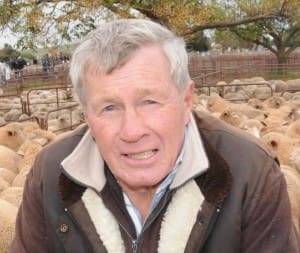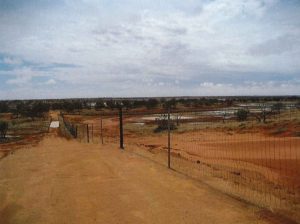
Orroroo grazier Geoff Power
MORE South Australian livestock producers need to contribute to maintenance of the state’s wild dog fence, according to former Livestock SA president Geoff Power.
The Orroroo pastoralist still represents Livestock SA on wild dog matters at the state and national level and said more funds are needed to accelerate the upgrading of the fence.
The SA Dog Fence starts on the cliffs of the Great Australian Bight, winding its way for 2186km northwards and eastwards until joining the NSW Dog Fence on the SA NSW border.
A SA Dog Fence Board inspection report in February this year highlighted several parts of the fence that need to be replaced or repaired.
Mr Power said the “real hotspots” for dog incursions through the fence were in the far north-east corner of the state, in the Maree area, the north Flinders Ranges and Roxby Downs.
According to an Overview of South Australian Dog Fence 2016-17 by SA Dog Board executive officer Michael Balharry, about 2000 properties in the state’s southern incorporated areas contributed about $219,000 to the maintenance of the fence.
In 2016-17, all pastoral properties and the farming properties on the far west coast protected by the northern dog fence which are 10 square kilometres or more pay a dog fence levy of $1.24 per square kilometre with a minimum rate of $103, which raised about $300,000.
The total amount raised from rates in 2016-17 was about $523,000 and these monies are matched by the State Government. Fence maintenance funds are allocated to each fence owner at a rate not exceeding $400/km of fence owned and local dog boards receives about $230/km. One pastoralist who owns 360km of fence is paid $209 per km to carry out maintenance and inspections.
Wild dogs are moving south in South Australia

The SA dog fence at Mulyungarie.
However, with wild dog incursions being reported along the SA barrier fence, Mr Power would like to see the area of South Australia able to be levied for fence maintenance funds extended.
“The dogs are moving south.
“In South Australia we have a $.9 billion sheep and wool industry and we are putting that at risk,” he said.
“The cattle blokes are affected too – they take calves.
“If everybody in the north and the west paid the levy which I believe is around $106; that would make a huge difference.”
Mr Power said the proposal to extend the area able to be levied dog fence rates is being negotiated with the State Government.
“It has to be a partnership between industry and government, I believe, we’ve got to have some skin in the game – we’re negotiating, we’re talking with government about it,” he said.
“I believe it should be everybody in the north and the north-west of the state.
“It is going to affect everybody if we don’t get on top of the problem.”
Mr Powers has fears that South Australia might end up like Queensland and Western Australia where large tracts of land were destocked due to wild dogs before exclusion fences were introduced.
Mr Power welcomed the State Government’s recent funding of two wild dog trappers to start on July 1, and $200,000 for the provision to landholders of an extra 100,000 manufactured and fresh meat baits in addition to 180,000 baits supplied through the Biteback program.
He said the fence is still a “great barrier” and everybody along it was doing a good job.
“But we need to accelerate the upgrading of the fence.”
Click here to read the SA dog fence February 2018 inspection report.

HAVE YOUR SAY